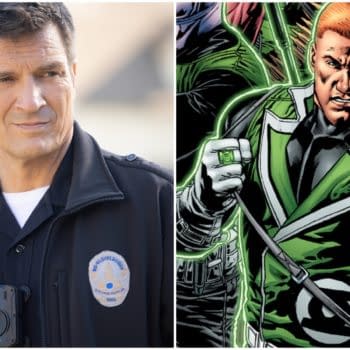Posted in: Movies, Recent Updates | Tagged: film, HRL
Geostorm Review: Not Bad Enough To Be Awful, Which Is The Worst Part
Geostorm is one of the worst movies of 2017.
Let's get that out of the way.
It's not bad enough to be awful — and that's the worst part. It's staggeringly mediocre. It commits the cardinal sin of being boring. It has the most colour-by-numbers script and characters you've seen a million times in the last 30 years of blockbuster movies.
It's like a remake of The Day After Tomorrow with an even sillier gimmick. There's a race to stop a conspiracy to use a weather-controlling satellite system to destroy large parts of the world for political game. It's a detective thriller with disasters where scores of nameless extras turn into popsicles. The dialogue is mind-numbing rote. Everything in this movie has been seen countless times before in loads of other, better movies.
Disaster movies are based on the idea that something in real life could become a big, scary problem. The issue with this movie is that it makes a problem out of something that doesn't exist, so it's not at all scary. Not even a little bit. We'd be lucky to have a series of orbiting satellites that controlled the weather and averted the storms brought about by climate change. But these satellites don't exist, so why would we be afraid?
The problem with this movie is that its premise is built on an abyss of total bollocks. It's not even about suspension of disbelief, because there is no belief to be had from the get-go. As a result, it's impossible to care about anything or anyone in it, because it's all nonsense enacted by a bunch of clichés.
The 4DX experience is the only thing that keeps this movie from becoming completely boring. It's really an updated version of those old cinematic gimmicks where they added mechanical extras to enhance the experience. This goes all the way back to the 1950s when William Castle electrified the seats to literally shock the audience watching his horror movie The Tingler. Then there was the 1970s gimmick of Sensurround, where the seats of a cinema had gears and hydraulics built under them to shock and rumble for disaster movies like Earthquake and Rollercoaster.
4DX seats are spruced up with hydraulics to lift, tip, and dip the audience to replicate the sense of movement and flow during scenes where things are moving. Fans on the ceiling blow wind at the audience during the storm scenes and tiny jets spray the audience in the face with water during the rain scenes. I don't know if many people going to the cinema would want to get water spritzed in their face every few minutes during a movie. We're not misbehaving cats that need to be controlled with a spray bottle.
There were also haptic panels built into the back of the seats that hammer on them to make it feel like you're being slammed and tossed and turned during the big crash scenes, but it often felt like the bored kid sitting behind you kicking your seat.
However, all the rocking and the bumping and wind and sprays of water didn't stop me from idly thinking about the parts of the movie beyond its relentless dullness.
The main tenet of disaster porn movies is to see what places get smashed up. Downtown Hong Kong, of course, gets trashed. Completely and utterly blathered. Reduced to a smoldering pit. This is not surprising, considering the movie is tailored to appeal to China. As far as the Chinese are concerned, Hong Kong is a hotbed of decadent corruption thanks to British colonialism, so it's no great loss, really. Poor Hong Kong.
Then I noticed that the places getting trashed were placed that the US and China don't like politically — Hong Kong, Japan, and India for China, and Moscow, Brazil (though I don't remember why), and Dubai for the US.
The three heroic Americans who save the day — the hero, his brother, and his brother's Secret Service girlfriend — are played by Gerard Butler, Jim Sturgess, and Abbie Cornish, two Brits and an Australian. The evil hacker turns out to be the obnoxious British guy played by Robert Sheehan, who vaguely resembles Marcus Hutchins, AKA MalwareTech. This was the British white hat hacker recently arrested in the US for allegedly writing malware. That's a very odd coincidence, considering the movie finished production at least a year before Hutchins's arrest a few months ago.
The movie pushes a liberal, Democrat-leaning message of cultural diversity and internationalism, yet liberally shows foreign and brown people getting washed away and flash-frozen. And the heroes are white Americans played by non-Americans. This is a very strange set of mixed messages.
And the way they stop the satellites causing the geostorms is to switch it off and on again. This entire movie is based on a common IT issue, and an old joke from The IT Crowd.
I was told that after negative reactions from test screenings of the original cut two years ago, new producer Jerry Bruckheimer hired genre screenwriter Laeta Kalogridis and director Danny Cannon to reshoot parts of the movie to spruce it up. You might recognise Cannon's name from his directing and Executive Producer credits on TV shows like more than one CSI franchise series and, currently, Gotham. I shudder to think how much worse the original version of this movie might have been.
At the end of the day, I don't regret seeing this movie, especially since I didn't have to pay for it. It was an educational experience — another look at the declining fortunes of bad blockbuster filmmaking.












